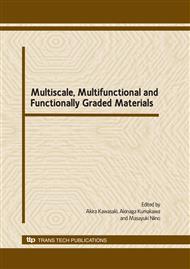p.115
p.121
p.127
p.135
p.141
p.149
p.155
p.161
p.167
Synthesis and Properties of Graded Porous Ti-TiO2 Multifunctional Composites Obtained by Different Processing Methods
Abstract:
Functionally graded materials for load bearing implants have a long history of academic development and an already high degree of maturity. Efforts are now undertaken to improve the biocompatibility and even induce bioactivity within the implant-bone interface by optimised surface nanostructure of porous ceramic and metalic layers grown or sintered on a metallic implant, in order to arrive at cementless implants capable of fast osteointegration and high interface strength. Several new methods for surface structure and composition modification are presented for Ti-alloy based implants: a nano-structuring of the surface by re-deposition of TiO2 using an ECR-Microwave Plasma treatment combined with ion bombardment on a sintered TiO2 ceramic surface, a multiscale modification of porous Ti-coatings by means of Micro-Arc-Oxidation, MAO, and a meso-structuring of the surface by means of a laser treatment. The goal is to establish a multi-functionality in such materials by formation of a morphological and compositional gradient spanning many dimensions. The applicability of these methods to real implants is discussed for a dental implant.
Info:
Periodical:
Pages:
141-146
Citation:
Online since:
October 2009
Authors:
Price:
Сopyright:
© 2010 Trans Tech Publications Ltd. All Rights Reserved
Share:
Citation:


